
Chinese farmers begin the clean up of the Chaohu lake, scooping up a pollution-linked algae bloom in Hefei, eastern China's Anhui province on June 5, 2008. Algae blooms are common on many Chinese freshwater lakes and are chiefly caused by untreated sewage containing high concentrations of nitrogen, a main ingredient in detergents and fertilisers, as more than 70 percent of China's waterways and 90 percent of its underground water have been contaminated by pollution.
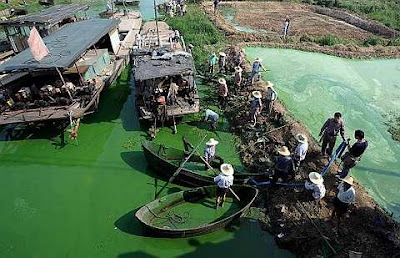



Chinese farmers begin the clean up of the Chaohu lake, scooping up a pollution-linked algae bloom in Hefei, eastern China's Anhui province on June 5, 2008. Algae blooms are common on many Chinese freshwater lakes and are chiefly caused by untreated sewage containing high concentrations of nitrogen, a main ingredient in detergents and fertilisers, as more than 70 percent of China's waterways and 90 percent of its underground water have been contaminated by pollution.

Chinese farmers pour green algae scooped up from the Chaohu lake, in Hefei, eastern China's Anhui province on June 5, 2008, into a pit. Algae blooms are common on many Chinese freshwater lakes and are chiefly caused by untreated sewage containing high concentrations of nitrogen, a main ingredient in detergents and fertilisers, as more than 70 percent of China's waterways and 90 percent of its underground water have been contaminated by pollution.
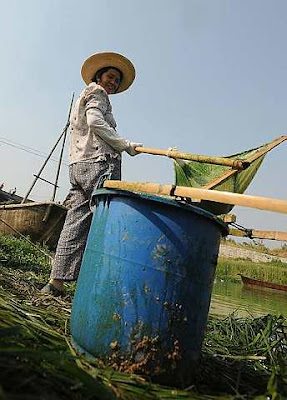
A Chinese farmer scoops up green algae from the Chaohu lake, in Hefei, eastern China's Anhui province on June 5, 2008. Algae blooms are common on many Chinese freshwater lakes and are chiefly caused by untreated sewage containing high concentrations of nitrogen, a main ingredient in detergents and fertilisers, as more than 70 percent of China's waterways and 90 percent of its underground water have been contaminated by pollution.

A Chinese farmer pours green algae scooped up from the Chaohu lake, in Hefei, eastern China's Anhui province on June 5, 2008, into a pit. Algae blooms are common on many Chinese freshwater lakes and are chiefly caused by untreated sewage containing high concentrations of nitrogen, a main ingredient in detergents and fertilisers, as more than 70 percent of China's waterways and 90 percent of its underground water have been contaminated by pollution.

A Chinese farmer begins the clean up of the Chaohu lake, scooping up a pollution-linked algae bloom in Hefei, eastern China's Anhui province on June 5, 2008. Algae blooms are common on many Chinese freshwater lakes and are chiefly caused by untreated sewage containing high concentrations of nitrogen, a main ingredient in detergents and fertilisers, as more than 70 percent of China's waterways and 90 percent of its underground water have been contaminated by pollution.
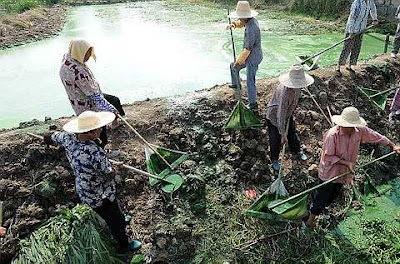
Chinese farmers begin the clean up of the Chaohu lake, scooping up a pollution-linked algae bloom in Hefei, eastern China's Anhui province on June 5, 2008. Algae blooms are common on many Chinese freshwater lakes and are chiefly caused by untreated sewage containing high concentrations of nitrogen, a main ingredient in detergents and fertilisers, as more than 70 percent of China's waterways and 90 percent of its underground water have been contaminated by pollution.

Small fishing boats tied to the banks of the Chaohu lake, where a pollution-linked algae bloom has reappeared, in Hefei, eastern China's Anhui province on June 4, 2008. Algae blooms are common on many Chinese freshwater lakes and are chiefly caused by untreated sewage containing high concentrations of nitrogen, a main ingredient in detergents and fertilisers, as more than 70 percent of China's waterways and 90 percent of its underground water have been contaminated by pollution.
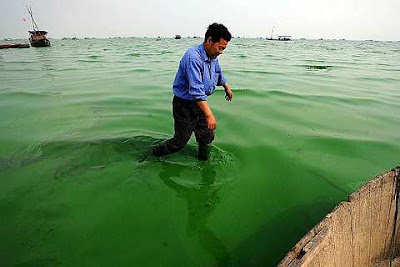
A Chinese fisherman ties his boat alongside a pier on the Chaohu lake, where a pollution-linked algae bloom has reappeared, in Hefei, eastern China's Anhui province on June 4, 2008. Algae blooms are common on many Chinese freshwater lakes and are chiefly caused by untreated sewage containing high concentrations of nitrogen, a main ingredient in detergents and fertilisers, as more than 70 percent of China's waterways and 90 percent of its underground water have been contaminated by pollution.
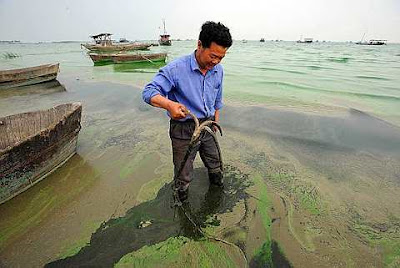
A Chinese fisherman ties his boat alongside a pier on the Chaohu lake, where a pollution-linked algae bloom has reappeared, in Hefei, eastern China's Anhui province on June 4, 2008. Algae blooms are common on many Chinese freshwater lakes and are chiefly caused by untreated sewage containing high concentrations of nitrogen, a main ingredient in detergents and fertilisers, as more than 70 percent of China's waterways and 90 percent of its underground water have been contaminated by pollution.
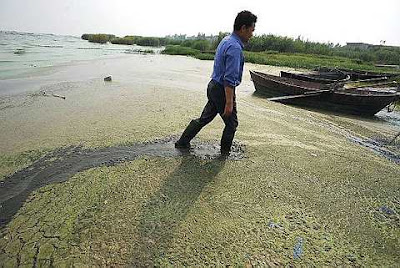
A Chinese fisherman ties his boat alongside a pier on the Chaohu lake, where a pollution-linked algae bloom has reappeared, in Hefei, eastern China's Anhui province on June 4, 2008. Algae blooms are common on many Chinese freshwater lakes and are chiefly caused by untreated sewage containing high concentrations of nitrogen, a main ingredient in detergents and fertilisers, as more than 70 percent of China's waterways and 90 percent of its underground water have been contaminated by pollution.

A Chinese fisherman ties his boat alongside a pier on the Chaohu lake, where a pollution-linked algae bloom has reappeared, in Hefei, eastern China's Anhui province on June 4, 2008. Algae blooms are common on many Chinese freshwater lakes and are chiefly caused by untreated sewage containing high concentrations of nitrogen, a main ingredient in detergents and fertilisers, as more than 70 percent of China's waterways and 90 percent of its underground water have been contaminated by pollution.

No comments:
Post a Comment